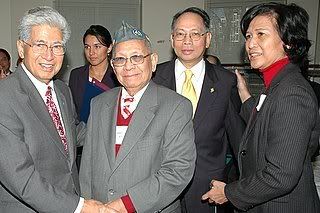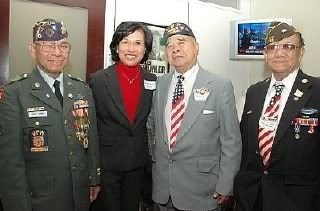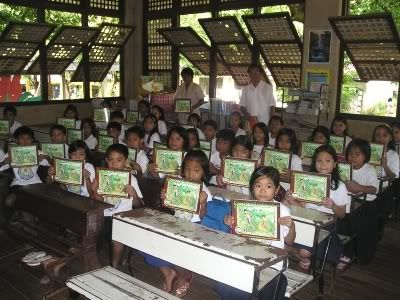Three weeks in Manila to attend the Jubilee Year celebration of my college fraternity during a season of monsoon rains happily brought back fond memories of childhood. With jet lag and all, the quaint patter of a downpour on the roof was just right for deep, undisturbed slumber. I dreamt I was again a carefree kid enjoying tampisaw in the rain, floating paper boats on swollen canals.
Metro Manila is changing. Giant malls and condos all over the place are transforming the skyline. Within these super structures called malls, aside from countless retailers, are restaurants with recipes so cooked and elegantly presented you’d think you were in a five-star joint in the U.S. Add-ons are the balikbayan-friendly prices and the ever-smiling service people.
If only traffic rules are enforced and the festering squatter shanties, ugly giant billboards, unruly jeepneys and buses are placed under control by authorities, Manila would give major Asian destinations stiff competition. Other drawbacks that we experienced first hand during this visit: (a) Manila’s international airport appears backward compared to stop-over ports of, say, Taiwan or Inchon. When we left on a wet Monday morning, the ceiling at the Manila airport’s departure area was pitifully leaking for all to see; airport toilets---although clean—appear shabby and badly in need of refurbishing; (b) Taxicabs entering the international airport bearing tourists are subjected to petty harassment at the main gate by security guards who are said to be protecting “authorized” cabs. (One such character on the early morning of July 24 had “F. Tayag” on his nameplate. Stern-looking and insisting on seeing the license of the cab driver, the IDs of passengers and asking all sorts of questions, he was clearly asserting power over a narrow turf. After ten minutes of explaining and pleas from cab passengers, gate guard F. Tayag arrogantly warns the cab driver not to go through that airport gate again.) Wow! How in the name of King Jeffrox would any unsuspecting tourist trying to catch a flight, navigating through Asia’s worst traffic mess, know which blessed cab in the city is authorized or not by gate guard F. Tayag? (c) Maintenance of buildings and general surroundings along main streets is almost non-existent. Structures and street signs along EDSA, Metro Manila’s main road, are unkempt if not dilapidated since we visited three years ago. Mayors of cities along EDSA should do some serious house cleaning. As if to add misery to the scenery, abusive, dangerous passenger buses plying EDSA run wild day and night—stopping wherever and whenever they please. If these buses cannot be disciplined they should be pulled out from main thoroughfares.
What we say here of course is easier said than done. Before anything moves at all in Pilipinas nating mahal, bureaucracy and red tape—if not politics—get in the way. Even the simple act of boarding a plane out of the international airport requires documents to be filled out, checked and re-checked, stickers that mar luggage are freely stuck on, security checks in three (repeat: three!) sections along the departure route are done by scores of airport employees, airline personnel and government hacks. No wonder, Manila’s premier airport, compared to those abroad, is always full of people. Observe closely. Bureaucrats and plain istambays (on stand-by) easily outnumber transient passengers any time of the day or night.
Some local critics we spoke to in the course of our stay shared interesting insights about the country’s present woes. To indulge in inflammatory topics makes it easy to slide into a complaining, critical mode about the homeland these days. But we certainly do not wish to come across whining and sounding all-knowing. I hasten to add that there also exist redeeming items worthy of mention in Metro Manila these days—things that were not readily seen when we last visited. Some that stand out: (a) Taxi cab service all over the city has vastly improved. For a little over a dollar (average PhP65-75 even with heavy traffic) one can go anywhere within the city on clean, air-conditioned cabs that operate with tamper-proof meters and courteous drivers in regulation white shirts. One feels secure unlike in the old days when scary dilapidated cabs were driven by operators that looked like thugs; (b) Food, always a key element in our culture, is now even better in Manila. Restaurant food, experts assert, is among the finest in the Southeast Asian region--and at quite reasonable prices. If you are a balikbayan with some baon dollars to spare, try hanging out at premium Metro Manila spots like Shangri-la Makati or the one on EDSA. Try their buffet. Or ask to be brought to La Tienda, Via Marre, Vizu, Bacolod Inasar, Razon, Dads, Dencio, Ardi’s, or Gloria Maris to name just a few memorable eating experiences. Buffet fare, in colorful splendor any gourmet would delight in, topped with warm, patented Filipino hospitality, are supposedly prepared only by world-caliber chefs; (c) Shopping—ask any woman---is at its finest. The tiangge at Greenhills in San Juan, the stupendously modern, newly-opened Mall of Asia in Pasay City and the mega malls of Makati, Mandaluyong and Quezon City have become favorite destinations of shoppers from all over the world. Visiting these places, we were always amused to overhear Europeans and Americans commenting on how they were enjoying the rich variety of jewelry, trinkets, garment, dry goods at prices they say they would never find in Bangkok, Hongkong or Singapore; (d) If restaurants have improved, so have world-class hotels and hostels with daily rates that are hard to beat. Ask around before booking and you will see that even top-season rates are quite affordable-- with terrific breakfast buffets tossed in as bonus; (e) Medical tourism is beginning to pick up. For those who want affordable cosmetic dentistry, facial or body make-over, tattoos, skin work, there are convenient package plans now available for balikbayans that include airfare, hotels, clinics, even trips to relaxing recovery spas for those who want holistic treatment. Ask your travel agent. These new travel packages target weary and overworked expatriate Filipinos from all over the world; (f) Nightlife? Well—Manila is still among the tops in Asia’s fun-seekers’ paradise. Connect with ‘knowledgeable locals’—and there are legions in Manila (if you do not wish to consult relatives or nose-y friends)---for safe, clean, memorable night life in the city and you too will want to work harder, save up more, stay fit and healthy so that you can return again and again and again. After staying 10,000 miles away in the last two decades, I now understand why Douglas was so determined to return.
**
Then there is this curious TV program called “Bahala si Bitag” (translation: Dragnet Takes Care) hosted by one more media crusader surnamed Tulfo. I caught two shows where the feisty mustachioed host scuffled with stubborn shotgun-wielding security guards, brought to the police station kotong (bribe-taking) barangay road traffic officers, monitored a food processing plant that was spilling and polluting Pasig River with harmful chemicals, and then showing the extent of fish farms set up by private interests apparently without enough supervision by the Laguna Lake Authority. Almost all of once-pristine Laguna Lake is now fenced-over by destructive fish farms that are reportedly owned by powerful ex-military and public officials. The producers of Bitag, IBC-UNTV Channel 13, display uncommon courage by accepting tips from the public. Tulfo and company are also living proof that there is hope after all. Downside is the disturbing number of journalists and broadcasters that are being “salvaged” by shadowy entities. As of last count, there were 48 media people all over the country that were ‘rubbed out’ for courageously exposing anomalous issues. Pundits say that the country owns one of the best-framed sets of laws in all of the free world as embodied in the Philippine Constitution. But it is clearly in enforcement of the law where authorities fail miserably. Root word here is “force.” Does that suggest that the country needs another strong man to instill discipline? It could well be an opportune time for the highly-touted law enforcers of the Philippines to demonstrate to the citizenry whether they are worth the taxes they are paid. If you are observant take a look at today’s governance: on the saddle is a lady who is supposed to be a housekeeper-economist per her bio-data; most in her cabinet are ex-military—from the executive secretary to the trade, public works, energy, and major enforcement portfolios. And her numero uno adviser-consultant-apologist is a former president who is also ex-military. With a team of powerful players like that, every Juan and naïve observers like me wonder: Where could the hitch be?
The statewide survey of Filipino World War II veterans is set to be launched this August with the final blessings of Olympia led by the Governor, the Veterans Administration Office, and the Commission on Asian Pacific American Affairs (CAPAA). Community leaders all over Washington state are being asked to please help in this effort to reach aging Filipino veterans who are going to benefit (or wish to benefit) from the Family Reunification. It will be part of the Immigration Reform Law that is being presently debated and lobbied at the U.S. Congress. In June, a provision sponsored by Senators from Washington State and Hawaii was unanimously passed by the U.S. Senate. A call for assistance is being issued by the Seattle-based Filipino War Veterans of Washington (FWVW) and the International Drop-In Center (IDIC).
**
Our condolences go to two dear friends who had passed away recently. Manila Reyes Paz, noted Ilongga Filipino folk dance instructor and cultural arts advocate, succumbed to diabetes on July 7. Tito de Santos, a beloved fraternity man of North California, passed away suddenly while visiting Manila for a reunion with fraternity brothers. He had led a successful medical mission to Davao.
**
World champion young female softball players from Bacolod are arriving again this August to play in the World Series in Kirkland. Kuya Bert Caoili and educator Roy Flores are spearheading the support group. Find time to show your support for these spunky Filipina champions who easily beat teams from industrial nations.
**
For pure fun, entertainment and sheer delight, no one comes close today to stage performer Willie Nepomuceno. This guy is destined for Las Vegas if his cards are played right. He performs for the first time in Seattle 7 PM, Saturday, August 26 at the U.W. Kane Hall. Bring the whole family. Tell friends. Witness how truly talented a Filipino can be if he is of Willie’s unique caliber. Sample: He mimics Nat and Natalie Cole in one unforgettable piece. If there’s a show worth your time this summer, it is Willie Nep. It’s the season’s super treat. Be there or you’ll be sorry. (By the way, Willie’s show will also honor Seattle’s aging Filipino WW II veterans).
Our Proverb for the Month:
Evaluate yourself by your own standards, not someone else’s.
Read More...
Summary only...








